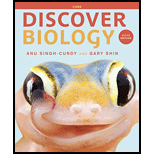
Concept explainers
Introduction: The solar radiation amount received by the Earth depends upon the location of the biome. The amount of received sunlight will be high if the biome is located at the equator, resulting in hot conditions in biome. At the poles, the biomes are cold due to the availability of less sunlight.
Answer to Problem 1SQ
Correct answer: The spherical shape of the earth causes the equator to receive more light. Therefore, option c. is correct.
Explanation of Solution
Reason for the correct statement:
At the equator, solar light strikes Earth directly at a slanted angel near the North and South Pole. The solar rays are concentrated on the smaller surface and thus increase the solar intensity at the equator. Hence, option c. is correct.
Reasons for the incorrect statement:
Option a. is given as “Earth is spinning on its axis”. The spinning of earth around its axis causes the difference in daytime and nighttime. Hence, it is a wrong answer.
Option b. is given as “Earth is revolving around the sun”. The revolution of the Earth around the sun causes different seasons. Hence, it is a wrong answer.
Option d. is given as “Earth’s surface is mostly water”. The earth surface is covered with about 70 percent of water. It absorbs large amounts of solar radiation without an increase in the temperature. Hence, it is a wrong answer.
Hence, options a., b., and d. are incorrect.
Want to see more full solutions like this?
Chapter 20 Solutions
Discover Biology (Sixth Core Edition)
 Human Anatomy & Physiology (11th Edition)BiologyISBN:9780134580999Author:Elaine N. Marieb, Katja N. HoehnPublisher:PEARSON
Human Anatomy & Physiology (11th Edition)BiologyISBN:9780134580999Author:Elaine N. Marieb, Katja N. HoehnPublisher:PEARSON Biology 2eBiologyISBN:9781947172517Author:Matthew Douglas, Jung Choi, Mary Ann ClarkPublisher:OpenStax
Biology 2eBiologyISBN:9781947172517Author:Matthew Douglas, Jung Choi, Mary Ann ClarkPublisher:OpenStax Anatomy & PhysiologyBiologyISBN:9781259398629Author:McKinley, Michael P., O'loughlin, Valerie Dean, Bidle, Theresa StouterPublisher:Mcgraw Hill Education,
Anatomy & PhysiologyBiologyISBN:9781259398629Author:McKinley, Michael P., O'loughlin, Valerie Dean, Bidle, Theresa StouterPublisher:Mcgraw Hill Education, Molecular Biology of the Cell (Sixth Edition)BiologyISBN:9780815344322Author:Bruce Alberts, Alexander D. Johnson, Julian Lewis, David Morgan, Martin Raff, Keith Roberts, Peter WalterPublisher:W. W. Norton & Company
Molecular Biology of the Cell (Sixth Edition)BiologyISBN:9780815344322Author:Bruce Alberts, Alexander D. Johnson, Julian Lewis, David Morgan, Martin Raff, Keith Roberts, Peter WalterPublisher:W. W. Norton & Company Laboratory Manual For Human Anatomy & PhysiologyBiologyISBN:9781260159363Author:Martin, Terry R., Prentice-craver, CynthiaPublisher:McGraw-Hill Publishing Co.
Laboratory Manual For Human Anatomy & PhysiologyBiologyISBN:9781260159363Author:Martin, Terry R., Prentice-craver, CynthiaPublisher:McGraw-Hill Publishing Co. Inquiry Into Life (16th Edition)BiologyISBN:9781260231700Author:Sylvia S. Mader, Michael WindelspechtPublisher:McGraw Hill Education
Inquiry Into Life (16th Edition)BiologyISBN:9781260231700Author:Sylvia S. Mader, Michael WindelspechtPublisher:McGraw Hill Education





